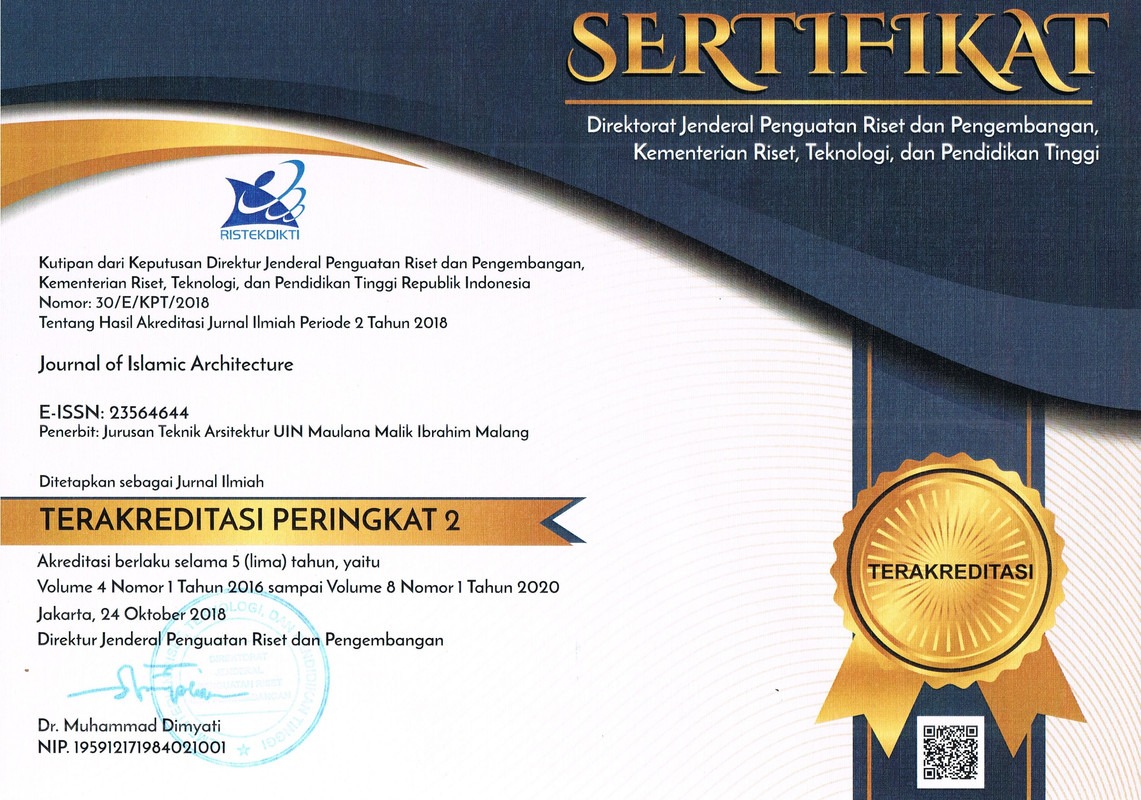SPATIAL PATTERNS OF ISLAMIC RELIGIOUS ACTIVITIES IN KRAPYAK DISTRICT, YOGYAKARTA
Abstract
Krapyak District is one of the significant areas in Yogyakarta, crossed by the
Philosophical Axis stretching from Tugu in the North to Panggung Krapyak in
the South end. The Javanese philosophy of Sangkan Paraning Dumadi lies
within the axis. In 2017, based on the Special Region of Yogyakarta
Governor's Decree Number 108, this axis was designated as the part of the
cultural heritage. As stated in the decree, the areas around the philosophical
axis must represent the meaning of Sangkan Paraning Dumadi, both in terms
of activities and spaces. Furthermore, the presence of Islamic boarding
schools, also known as pesantren, helps to transform Krapyak District into a
solid Islamic community. This study aims to identify the relation between
activity patterns and the built environment in Krapyak District. The harmony
between activity patterns, the built environment, and the meaning of a
complex philosophical axis of Krapyak District is fascinating to investigate,
especially in light of the district's environmental issues. This study used a
deductive approach with a descriptive-qualitative method based on the
behavioral space system model of place-centered mapping. It is concluded
that there are three layers of activity and space, namely the religious layer,
the socio-cultural layer, and the philosophical axis layer, that interact one
another with some specific spatial patterns.
Keywords
Full Text:
PDFReferences
M.A.M., Kamal, “Interelasi Nilai Jawa dan Islam dalam Berbagai Aspek Kehidupan”, Kalam, Vol.10, No.1, 19–42, 2016, doi: https://
doi.org/10.24042/klm.v10i1.18
J. Spradley, Participant Observation (Vol. 1), United States of America: Holt, Rinehart, and Winston, 1980, doi: https://doi.org/10.1017/CBO9781107415324.004
Muhaimin, “Kedudukan Kearifan Lokal Dalam Penataan Ruang Provinsi Bali”, Jurnal Penelitian Hukum De Jure, Vol. 18, No. 1, pp. 59–71, 2018, DOI: http://dx.doi.org/10.30641/dejure.2018.V18.59-71
S. Hadi, E. Soetarto, & S. Sunito, “Desa Pesantren Dan Reproduksi Kiai Kampung”, Analisis Jurnal Studi Keislaman, Vol. 16, No. 1, 33–66, 2016, doi: https://doi.org/10.24042/ajsk.v16i1.736
M. Sofer, “The Rural-urban Fringe: Theoretical Issues and Israeli Experience”, Landscape and Geodiversity, issue 1, 1–8, 2014.
Y. E. Putrie, & L. Maslucha, “Seting Perilaku dan Teritorialitas Ruang Sebagai Perwujudan Adab di Masjid Gading Pesantren Kota Malang”, El
Harakah Jurnal Budaya Islam, Vol. 15, No. 2, pp.1–5, 2013, DOI: https://doi.org/10.18860/el.v15i2.2765.
Haryadi & B. Setiawan, Arsitektur Lingkungan dan Perilaku. Yogyakarta: Gadjah Mada University Press, 2010.
F. S. Chapin Jr., Urban Land Use Planning. Urbana: University of Illinois Press, 1965.
A. Rapoport, Human Aspects of Urban Form, Oxford: Pergamon Press Ltd, 1977.
J. Lang, Creating Architectural Theory: The Role of The Behavioral Sciences in Environmental Design. New York: Van Nostrand Reinhold
Company Inc, 1987.
M. S. Hakim, “Perbedaan antara Ibadah Mahdhah dan Ibadah Ghairu Mahdhah”, Muslim.or.id., 2019, http://muslim.or.id/46004-
perbedaan-antara-ibadah-mahdhah-dan-ibadahghairu-mahdhah-bag-1.html, (Accessed 17 May 2019).
M. Niam, “Tiga Level Syariat dan Cara Memaknainya”, NUOnline, 2015, http://www.nu.or.id/post/read/63130/tiga-level-syariat-dan-cara-memaknainya, (Accessed 4 December 2018).
R. A. Sudrajad, Pengaruh Aktivitas Keagamaan Islam terhadap Aspek Sosial-Budaya Kawasan Krapyak. Bachelor Program Final Project. Urban and Regional Planning Program. Department of Architecture and Planning. Faculty of Engineering, Universitas Gadjah Mada, 2019.
DOI: https://doi.org/10.18860/jia.v6i4.12575
Refbacks
- There are currently no refbacks.







